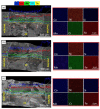Welding Techniques for High Entropy Alloys: Processes, Properties, Characterization, and Challenges
- PMID: 35329725
- PMCID: PMC8948684
- DOI: 10.3390/ma15062273
Welding Techniques for High Entropy Alloys: Processes, Properties, Characterization, and Challenges
Abstract
High entropy alloys (HEAs) are the outstanding innovations in materials science and engineering in the early 21st century. HEAs consist of multiple elements with equiatomic or near equiatomic compositions, which exhibit superior mechanical properties, such as wear resistance, fatigue resistance, and corrosion resistance. HEAs are primarily used in structural and functional applications; hence, appropriate welding processes are essential to enhancing the performances and service lives of HEA components. Herein, a comprehensive overview of current state-of-art-of welding techniques for HEAs is elucidated. More specifically, the article discusses the fusion-based welding techniques, such as gas tungsten arc welding (GTAW) and laser beam welding (LBW), and solid-state welding techniques, such as friction stir welding (FSW) and explosive welding (EB), for a broad category of HEAs. In addition, the microstructural features and mechanical properties of HEAs welded using different techniques were explained for a broad spectrum of HEAs. Finally, this review discusses potential challenges in the welding of HEAs.
Keywords: fusion welding; high entropy alloys; mechanical properties; microstructure; solid-state welding; welding.
Conflict of interest statement
The authors declare no conflict of interest. The funders had no role in the design of the study; in the collection, analyses, or interpretation of data; in the writing of the manuscript, or in the decision to publish the results.
Figures

















References
-
- Ostovari Moghaddam A., Shaburova N.A., Samodurova M.N., Abdollahzadeh A., Trofimov E.A. Additive Manufacturing of High Entropy Alloys: A Practical Review. J. Mater. Sci. Technol. 2021;77:131–162. doi: 10.1016/j.jmst.2020.11.029. - DOI
-
- Kushwaha A.K., John M., Misra M., Menezes P.L. Nanocrystalline Materials: Synthesis, Characterization, Properties, and Applications. Crystals. 2021;11:1317. doi: 10.3390/cryst11111317. - DOI
-
- John M., Ralls A.M., Dooley S.C., Thazhathidathil A.K.V., Perka A.K., Kuruveri U.B., Menezes P.L. Ultrasonic Surface Rolling Process: Properties, Characterization, and Applications. Appl. Sci. 2021;11:10986. doi: 10.3390/app112210986. - DOI
-
- Bhat K.U., Panemangalore D.B., Kuruveri S.B., John M., Menezes P.L. Surface Modification of 6xxx Series Aluminum Alloys. Coatings. 2022;12:180. doi: 10.3390/coatings12020180. - DOI
Publication types
LinkOut - more resources
Full Text Sources

